

Matching Patterns and Processing Information with awk. This chapter describes the awk command, a tool with the ability to match lines of text in a file and a set of commands that you can use to manipulate the matched lines.
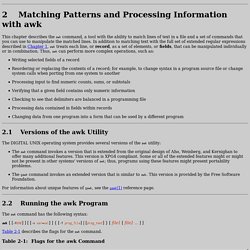
In addition to matching text with the full set of extended regular expressions described in Chapter 1, awk treats each line, or record, as a set of elements, or fields, that can be manipulated individually or in combination. Thus, awk can perform more complex operations, such as: Writing selected fields of a record Reordering or replacing the contents of a record; for example, to change syntax in a program source file or change system calls when porting from one system to another Processing input to find numeric counts, sums, or subtotals Verifying that a given field contains only numeric information Checking to see that delimiters are balanced in a programming file Processing data contained in fields within records Changing data from one program into a form that can be used by a different program.
How do multiple blocks work in AWK? Awk(1): pattern scanning/processing. Name gawk - pattern scanning and processing language Synopsis gawk [ POSIX or GNU style options ] -f program-file [ -- ] file ... gawk [ POSIX or GNU style options ] [ -- ] program-text file ... pgawk [ POSIX or GNU style options ] -f program-file [ -- ] file ... pgawk [ POSIX or GNU style options ] [ -- ] program-text file ... Description. String Functions (The GNU Awk User’s Guide) Gawk understands locales (see section Where You Are Makes a Difference) and does all string processing in terms of characters, not bytes.
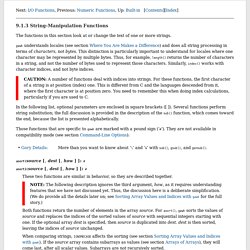
This distinction is particularly important to understand for locales where one character may be represented by multiple bytes. Thus, for example, length() returns the number of characters in a string, and not the number of bytes used to represent those characters. Similarly, index() works with character indices, and not byte indices. In the following list, optional parameters are enclosed in square brackets ([ ]). Several functions perform string substitution; the full discussion is provided in the description of the sub() function, which comes toward the end, because the list is presented alphabetically. String Extraction (The GNU Awk User’s Guide) 13.4.1 Extracting Marked Strings Once your awk program is working, and all the strings have been marked and you’ve set (and perhaps bound) the text domain, it is time to produce translations.
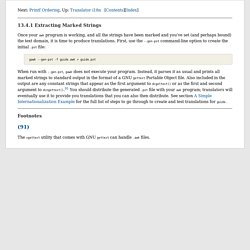
First, use the --gen-pot command-line option to create the initial .pot file: gawk --gen-pot -f guide.awk > guide.pot When run with --gen-pot, gawk does not execute your program. Instead, it parses it as usual and prints all marked strings to standard output in the format of a GNU gettext Portable Object file. POSIX String Comparison (The GNU Awk User’s Guide) 6.3.2.3 String Comparison Based on Locale Collating Order The POSIX standard used to say that all string comparisons are performed based on the locale’s collating order.
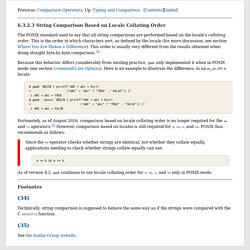
This is the order in which characters sort, as defined by the locale (for more discussion, see section Where You Are Makes a Difference). This order is usually very different from the results obtained when doing straight byte-by-byte comparison.34. I18N Functions (The GNU Awk User’s Guide) Strings And Numbers (The GNU Awk User’s Guide) 6.1.4.1 How awk Converts Between Strings and Numbers Strings are converted to numbers and numbers are converted to strings, if the context of the awk program demands it.

For example, if the value of either foo or bar in the expression ‘foo + bar’ happens to be a string, it is converted to a number before the addition is performed. If numeric values appear in string concatenation, they are converted to strings. Consider the following: Escape Sequences (The GNU Awk User’s Guide) 3.2 Escape Sequences Some characters cannot be included literally in string constants ("foo") or regexp constants (/foo/).
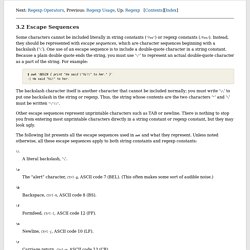
Instead, they should be represented with escape sequences, which are character sequences beginning with a backslash (‘\’). One use of an escape sequence is to include a double-quote character in a string constant. Because a plain double quote ends the string, you must use ‘\"’ to represent an actual double-quote character as a part of the string.
For example: String Functions (The GNU Awk User’s Guide) Gawk understands locales (see section Where You Are Makes a Difference) and does all string processing in terms of characters, not bytes.
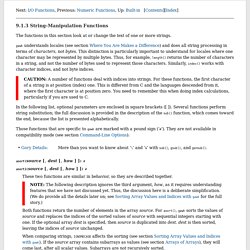
This distinction is particularly important to understand for locales where one character may be represented by multiple bytes. Thus, for example, length() returns the number of characters in a string, and not the number of bytes used to represent those characters. Similarly, index() works with character indices, and not byte indices.
Bracket Expressions (The GNU Awk User’s Guide) 3.4 Using Bracket Expressions As mentioned earlier, a bracket expression matches any character among those listed between the opening and closing square brackets.
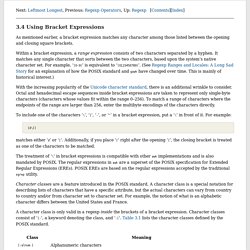
Within a bracket expression, a range expression consists of two characters separated by a hyphen. It matches any single character that sorts between the two characters, based upon the system’s native character set. For example, ‘[0-9]’ is equivalent to ‘[0123456789]’. (See Regexp Ranges and Locales: A Long Sad Story for an explanation of how the POSIX standard and gawk have changed over time. With the increasing popularity of the Unicode character standard, there is an additional wrinkle to consider. To include one of the characters ‘\’, ‘]’, ‘-’, or ‘^’ in a bracket expression, put a ‘\’ in front of it.
Matches either ‘d’ or ‘]’. Expression Patterns (The GNU Awk User’s Guide) 7.1.2 Expressions as Patterns Any awk expression is valid as an awk pattern.
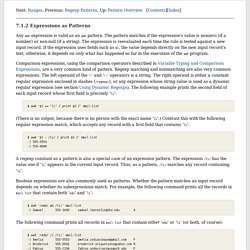
The pattern matches if the expression’s value is nonzero (if a number) or non-null (if a string). The expression is reevaluated each time the rule is tested against a new input record. If the expression uses fields such as $1, the value depends directly on the new input record’s text; otherwise, it depends on only what has happened so far in the execution of the awk program. Comparison expressions, using the comparison operators described in Variable Typing and Comparison Expressions, are a very common kind of pattern. . $ awk '$1 == "li" { print $2 }' mail-list (There is no output, because there is no person with the exact name ‘li’.) Switch Statement (The GNU Awk User’s Guide) 7.4.5 The switch Statement This section describes a gawk-specific feature.
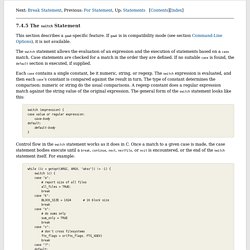
If gawk is in compatibility mode (see section Command-Line Options), it is not available. The switch statement allows the evaluation of an expression and the execution of statements based on a case match. Patterns and Actions (The GNU Awk User’s Guide) Return Statement (The GNU Awk User’s Guide) 9.2.4 The return Statement As seen in several earlier examples, the body of a user-defined function can contain a return statement. This statement returns control to the calling part of the awk program. It can also be used to return a value for use in the rest of the awk program. It looks like this: The part is optional. A return statement without an is assumed at the end of every function definition. Sometimes, you want to write a function for what it does, not for what it returns. AWK - Loops - Tutorialspoint. Advertisements This chapter explains AWK's loops with suitable example. Loops are used to execute a set of actions in a repeated manner.
The loop execution continues as long as the loop condition is true. For Loop The syntax of for loop is − Syntax. AWK - User Defined Functions - Tutorialspoint. Advertisements Functions are basic building blocks of a program. AWK allows us to define our own functions. A large program can be divided into functions and each function can be written/tested independently. It provides re-usability of code. AWK Language Programming - Built-in Functions. Go to the first, previous, next, last section, table of contents. Built-in functions are functions that are always available for your awk program to call. This chapter defines all the built-in functions in awk; some of them are mentioned in other sections, but they are summarized here for your convenience.
(You can also define new functions yourself. AWK - Miscellaneous Functions - Tutorialspoint. AWK - Built-in Functions - Tutorialspoint.
Shell Quoting (The GNU Awk User’s Guide) 10.2.9 Quoting Strings to Pass to the Shell Michael Brennan offers the following programming pattern, which he uses frequently: #! /bin/sh awkp=' … ' | awk "$awkp" | /bin/sh For example, a program of his named flac-edit has this form: Top (The GNU Awk User’s Guide) Statements (The GNU Awk User’s Guide) 7.4 Control Statements in Actions Control statements, such as if, while, and so on, control the flow of execution in awk programs. The GNU Awk User's Guide. Node:Top, Next:Foreword, Previous:(dir), Up:(dir) General Introduction This file documents awk, a program that you can use to select particular records in a file and perform operations upon them. Copyright © 1989, 1991, 1992, 1993, 1996, 1997, 1998, 1999, 2000, 2001, 2002 Free Software Foundation, Inc. Top (The GNU Awk User’s Guide) Comments (The GNU Awk User’s Guide) 1.1.5 Comments in awk Programs. Fields (The GNU Awk User’s Guide) 4.2 Examining Fields.
Field Separators (The GNU Awk User’s Guide) 4.5 Specifying How Fields Are Separated. Variable Scope (The GNU Awk User’s Guide) 9.2.3.2 Controlling Variable Scope Unlike in many languages, there is no way to make a variable local to a { … } block in awk, but you can make a variable local to a function. It is good practice to do so whenever a variable is needed only in that function. To make a variable local to a function, simply declare the variable as an argument after the actual function arguments (see section Function Definition Syntax). Look at the following example, where variable i is a global variable used by both functions foo() and bar(): AWK Language Programming - Arrays in awk. Go to the first, previous, next, last section, table of contents. An array is a table of values, called elements. The elements of an array are distinguished by their indices. Indices may be either numbers or strings. awk maintains a single set of names that may be used for naming variables, arrays and functions (see section User-defined Functions).
Passing arrays in awk function. Return an array of strings from user defined function in awk. How do multiple blocks work in AWK? AWK (Linux)